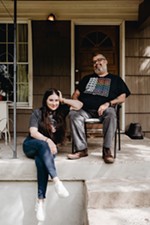Are Chef-to-Table Meal Services the Future of Cheffing?
No restaurant? No problem.
By A. Richmond, Fri., Nov. 11, 2022
As someone who thinks about food most of the time and falls asleep while cataloging breakfast items, I still do not willingly embrace meal planning and prep. Not because I don't love it. Because cooking, along with laundry or lawn care, is a quotidian task: The need to eat never stops, which is why restaurants and, by extension, chefs are integral to our daily lives.
When the pandemic hit, many of the restaurant industry's weak spots came into relief, and we nonindustry people who still didn't want to cook had to pivot from dining in restaurants to curbside delivery and meal kits. An even easier and more appealing option after sitting in front of Zoom meetings all day is buying already-made meals; you only have to heat – plate them if you must – before scarfing.
One such ready-to-eat meal company, CookUnity, somehow found me via an email offer in April 2022. The deal was 40% off my first order, and the tease was meals made by Iron Chef and longtime restaurateur Jose Garces. I hungrily signed up and learned that chef Garces' meals are only available to CookUnity customers in Brooklyn, Chicago, and Philadelphia. This did not stop me from signing up for four meals a week, then upping that to six. The meals were all mostly out-of-the-park-home-run delicious, all in a rich, homestyle, chef-y, balanced way. Perhaps because CookUnity, calling itself the first-ever "chef-to-table" platform, onboards local chefs, most of whom have run their own restaurants. And yet somehow, the chefs like cooking this way.
What is a chef-to-table platform, and will it change the way you eat? CookUnity launched in NYC in 2018, and after raising $70 million in venture capital funds, quietly expanded nationally, including into Austin, by fall 2021. CookUnity connects eaters with local chefs via app or website. To hear it from former Austin restaurant owner and culinary educator Maribel Rivero, CookUnity's model benefits chefs by taking away the tedious tasks and letting them focus on recipe creation. Over the phone, chef Rivero sounded bubbly when talking about her experience working for the platform.
"I was one of the first to sign on [in Austin]. I was doing catering individually and knew I couldn't have the same reach. As an independent chef, it's appealing." She onboarded to the platform in September 2021 and hasn't looked back.
Rivero, who once owned Manor Road Peruvian restaurant Yuyo, explained the model: CookUnity provides the kitchen and buys and sources all the food. They handle all the logistics and packaging, including putting a photo of the specific chef's smiling face on every box, plus delivery. CookUnity makes money for every meal someone orders, the chef gets a percentage, then the chefs pay their team. "They find the customers, then they notify us how many customers we have via the app. We don't do anything but cook and take care of labor," said Rivero.
As Yuyo's executive chef, it took Rivero nine months to find a vendor to provide choclo, Peruvian corn. Rivero plans to bring back her version of arroz con choclo, featured on Yuyo's menu, to CookUnity in the near future, with the choclo sourced by CookUnity.
Rivero came to the platform with eight different dinners. Her dishes are simple-seeming, chef-elevated fare like grilled chicken and grilled veggies tied together with a rich chimichurri and smoky eggplant puree. Rivero also offers bright, clean interpretations of the homestyle Tex-Mex dishes she grew up with. She explained her reasons for her meal offerings.
"Most of the chefs keep in their lane, or try to provide something that another chef does not. But people still want their homestyle classics. At first I started out with Peruvian dishes, and I have a few favorites that I will keep on. But customers get finicky."
Rivero teased a Uruguayan dish she has coming to the platform soon: "It's just grilled fish with a chimichurri, and rice with its own chimichurri that I featured at Yuyo, and charred tomatoes and caramelized onions. Plus corn in the rice!"
Like Rivero, Garces was recruited to CookUnity. I had to ask: Why would an Iron Chef with his own restaurants and website (garcesgroup.com) want to sell meals via another online platform?
He said, "I like the community aspect. There are multiple chef teams collaborating under one roof, there's some camaraderie. It's a challenge to source local, fresh ingredients, and CU takes care of that, which makes sense for all the chef teams. And during the pandemic, that was not a time to go out to eat. I'm glad I had the outlet." Garces said he was surprised to find he was looking at preparing food in a new way.
"Cooking large meals in abundance, and making sure they are all fresh and have the same level of quality, there is a lot to learn. I started to think about the nutritional balance of my meals, where previously, I've been piling on the flavor." Garces eats the same CookUnity meals anyone in his delivery area might eat.
Garces said, "I order the meals for myself, for quality assurance purposes, and for my family. I think it's good. I'm not just saying that, it's a great home-cooked option."
The chefs I spoke to seemed happy with the deal, but they have some kind of restaurant, national profile, and various "entrepreneur" moves prior to getting scouted by CookUnity. Like WeWork, the CookUnity model seems to be aimed at nationally dominating the market, but not just with real estate – with matching the regional/local cooks with the customer.
What about a hyperlocal model, in that the heat-and-eat meals you're buying in semi-bulk (4-8 meals per week) were made locally, by an Austin chef who grew up here and wants to live a balanced life and serve delicious food? That would be Lucky Lime, founded by native Austinite Rebecca Meeker, a former chef at Jeffrey's and Josephine House. She explained her plan to make meals: "In 2017, I left my job and was seeking a more balanced lifestyle. I wanted to make craveworthy meals that were also healthy."
She launched Lucky Lime in 2018 and currently makes 1,000 meals per week for weekly subscribers, plus has grab-and-go items at Thom's Market, Tiny Grocer, and Royal Blue. Or you can stop by the Lucky Lime kitchen window at GhostLine Kitchens after placing an online order via eatluckylime.com. The new platform is powered by Prado, a local company assisting meal prep businesses – which kind of sounds like the CookUnity model.
"It's going well," Meeker said modestly. And she doesn't do it alone (or with VC funding). Along with her prep team, she works with marketing, design, and advertising agency Whitebox to create the Lucky Lime branding and packaging.
But will the business model work? CookUnity only just expanded into Austin. Lucky Lime wants to only serve Austin; Meeker said she may consider expanding to Houston or Dallas, but has no plans for national expansion. So I had to ask someone who chose a long time ago to get out of the precooked meal delivery game what they thought of the general business model. The Soup Peddler's David Ansel used to offer a similar ready-to-eat weekly meal delivery option, but discontinued it years ago. Ansel saw the future of the Soup Peddler being good food and quick service via convenient locations, and you know how that story turned out: They became an Austin staple with five locations.
Ansel, who is quietly proud of the Soup Peddler's always-fresh-and-healthy yet indulgent offerings, was blunt when recalling his former meal program: "Well, it was sort of failing. The logistics were hard. Our brand didn't seem like it was being embraced by younger, hipper Austinites; the healthier stuff we were offering wasn't popular. We weren't able to do fresh things. Everything was cooked, cooled, then had to be reheated by the customer. And the customer had to place their order a week in advance."
Well, when you put it like that, the logistics do seem hard. I don't remember minding ordering Soup Peddler's meals a week in advance, I only remember being thrilled to 1) have them arrive at my door, and 2) eat them. As someone who always thinks about food, planning ahead and being rewarded with excellent meals is a small thrill. Not as much of a thrill as eating a perfect Caribbean chicken stew with rice and peas that taste like a chef created it, because one did. That's a bigger thrill, and one that has the potential to spread like wildfire among Austin's increasingly young, monied, and on-the-go population.
And with many restaurants and chefs digging themselves out of the gap created by the pandemic, the CookUnity model connects eaters with chefs who find themselves "between" restaurants, are waiting for the real estate market to correct in their favor, or want to grow their catering business without increasing overhead. And it might not have any impact on the traditional restaurant model, if chefs like Jose Garces embrace it. Because the meal itself, while required multiple times daily, is not a substitute for the in-person restaurant experience, which we all learned during the pandemic.
That said, this model could provide a middle path not only for chefs, but also for those who want a restaurant-quality meal without having to change out of their pajamas. And that's a win for everyone.











